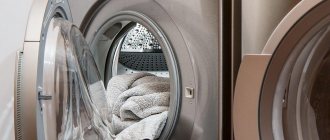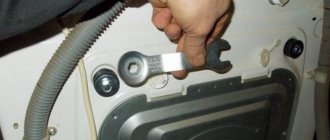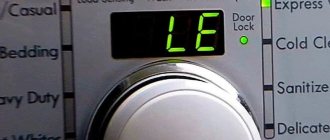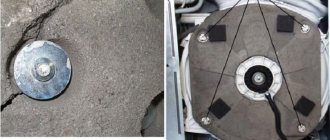The phrase that the car “galloped off somewhere” looks comical only at first glance. Anyone who has encountered such a problem understands that if the washing machine vibrates a lot during the spin cycle, nothing good can happen. At a minimum, loud sounds irritate households and neighbors, and at maximum, this behavior of the washing machine indicates that some kind of malfunction has occurred.
Your assistant also decided to have a “race” and started jumping unusually? Listen to this “cry for help” and don’t let things take their course. Otherwise, forgive the pun, gravity may occur in your own home - a machine that has “jumped” far away can easily become disconnected from the drain hose or water supply hose, and then a flood of the house is guaranteed.
However, strong vibration and “escape” from the location are only consequences. It is much more important to understand the causes and eliminate them before more serious problems arise.
Main reasons
Have you suddenly discovered that your washing machine is jumping during the spin cycle? The situation is, of course, bad, because this behavior of household appliances can lead to various very undesirable consequences. For example, it can damage your finishes in the bathroom or kitchen, and if installed above the floor on a pedestal, it can even topple over and become damaged. It is better to avoid such strange behavior and wait for something serious to happen.
The washing machine is jumping - set it straight
Machine design
To understand why a washing machine jumps, you need to familiarize yourself with its design. In general, she simply cannot help but jump. Of course, this is her abnormal behavior, but the vibration must be present, because all the conditions are present for its occurrence. Firstly, the drum is suspended on springs inside. Secondly, very often laundry weighs more than it should. As for the ballast, it is adjusted to a specific type of load.
Let's look at the design of the machine so that we can understand which parts can cause vibration:
- Inside there is a casing that is suspended from the body using springs. Dampers are also used as stretch marks. These are some kind of shock absorbers, only there is no pressure in them. The rod moves tightly due to the seals inside which it is installed.
- The drum is mounted on just one axis and two bearings pressed into the casing.
- The drum rotates the motor through a belt and a large pulley. By the way, it is made of duralumin, so it can be bent and broken quite easily.
- Ballast is suspended from the casing - this is usually one or two blocks of concrete, which must compensate for the deviations, creating a counterforce directed in the opposite direction to the force rocking the drum.
Types of Vibrating Machines
There are certain rules by which their ability to vibrate can be determined. Do not forget that it is impossible to completely eliminate vibration. High revolutions, according to the laws of physics, provoke this phenomenon even in well-installed machines.
Narrow models of LG machines can shake and make noise the most. This happens because they have insufficient support area. Consequently, the car has poor stability, which leads to jumps. Also, the small machine is equipped with a narrow drum, so laundry often bunches up in it, thereby causing an imbalance in the drum.
Troubleshooting
Let's try to study in more detail possible breakdowns and ways to fix them yourself. Because some problems can still be solved without even disassembling the washing machine body. It is better to entrust problems with disassembly to the hands of the craftsmen from the service center, because a lot could happen over several years of active use. We will analyze situations in which the user can do something himself.
Incorrect installation
This is a common problem that is associated with the fact that the equipment is not aligned with the horizon. Any equipment whose design contains suspensions and oscillatory movements requires precise alignment. If this is not done, the center of mass of the drum will shift to the side and knocking will be unpleasant.
At high speeds, beats will occur, which will lead to the machine moving from its place. To set up equipment, you must use a level. You should take a longer length than 60 cm so that it lies on the ribs on the sides. It should be displayed in two planes. First longitudinal, then transverse. Installation is carried out using special adjustable legs. They are rubberized specifically to partially compensate for vibration and to prevent the equipment from slipping on the tiles. Adjustment is made by screwing or unscrewing these feet from all 4 corners.
In addition to aligning the washing machine by twisting or twisting the legs, it is also worth determining whether the floor is level. Of course, even significant deviations from the horizon can be adjusted with the legs, but it is still better that the surface is also flat. In addition, the legs are not controlled, so with slight vibration they can twist, which will lead to further increased swaying of the case. To eliminate this defect, it is recommended to place thin pieces of rubber under the legs, which will additionally compensate for the amplitude of jumps.
Structural failure: bearing failure
The main reason why a washing machine vibrates during the spin cycle is because the bearings wear out. Moreover, this is an inevitable process, especially if they were installed of poor quality. During operation, they are subject to forces that tend to deflect the axis to the side.
The bearing serves to hold it and thereby ensure easy rotation. Due to the force acting perpendicular to the shaft, generation occurs in the inner and outer race and the balls themselves. This is usually visible from potholes and abrasions on parts. The complexity of this reason lies in the fact that along with the vibration of the drum, a leak very often occurs. That is why it is better to notice the problem as early as possible, so as not to replace other parts.
This problem is also considered difficult for the reason that it is almost impossible to eliminate it with your own hands. At a minimum, you will need professionalism and special tools to knock out the bearings. But you can independently determine that they are still depleted. This is done very simply. It is necessary to rock the drum back and forth, like a wheel when checking for play in the hub. There shouldn't be any beats at all.
Spring wear
As previously indicated when familiarizing yourself with the design of this technique, it usually contains 2 or 4 springs. These are quite powerful products made of thick spring steel with a rod diameter of at least 3 mm. It is present at both ends of the ring, with the help of which it is suspended in the body and holds the drum in this state. They must ensure partially free movement of the drum so that the body does not swing. They are attached to special lugs in the housing.
Spring wear
In some cases, due to poor quality of the metal or non-compliance with the hardening technology, the springs are less durable and soon become old. This leads to their deformation (extension) and relative elongation. As a result, the drum is again shifted to the side, due to which unevenly acting forces arise, leading to its swinging.
What do experts advise when your washing machine jumps?
- Use the included noise-insulating rubber or silicone pads for the legs;
- When installing, lay an additional soundproofing layer behind the wall of the machine;
- Built-in models require additional space to prevent the headset from loosening;
- Load the equipment so that it is 1/3 free;
- Remove shipping bolts before installation and connection;
- Use a magnet or vacuum cleaner to remove small objects;
- Sort items by size and fabric type before storing;
- It is better to entrust the replacement of the engine, bearings, and springs to a specialist.
Watch a video about what to do if the washing machine jumps during the spin cycle
Is it worth doing the repairs yourself?
A washing machine may be a relatively simple household appliance, but in fact, it only seems so, because it, like any other, has many nuances. In particular, there can be many reasons why the washing machine is jumping. In order to correctly diagnose a specific one, it is better to immediately contact a service center.
Specialists will conduct a series of tests and quickly determine the breakdown. They also willingly provide advisory services to their clients. In particular, they will help to correctly diagnose. For example, to identify wear in a bearing, you need to shake the drum toward and away from you. If you feel a knocking sound, then this is production. During rotation it will be thrown from side to side.
As for determining the wear in springs and dampers, this can also be done quite easily. Press the drum exactly in the middle and release it quickly. Normally, it should jump up and down evenly until it stops. If it is carried away to the side from the first pitch, then there are problems with depreciation.
It is important to identify defects in time, because constant vibration and jumping can lead to rupture of pipes, cuffs, damage to the seal and, as a result, leakage. This, in turn, can cause other more serious external problems. By the way, if you are thinking about buying a new washing machine, it is better to purchase equipment with direct drive. LG has a license to produce such a machine. Due to the absence of a belt, pulley and thicker shaft, the number of possible causes of vibration is significantly reduced.
Shock absorbers
The first and quite serious breakdown is the shock absorbers. Usually there are two of them (rarely four), they hold the drum from below. If they don't work new, then it's just a defect and needs to be replaced under warranty. BUT they mostly fail due to prolonged use (like shock absorbers on a car).
At the same time, the machine loses its dampening properties and begins to jump and rumble; many write that it still wanders either throughout the kitchen, or in the bathroom or bathroom (depending on who it is).
It happens that these shock absorbers simply break, one of the fastenings simply breaks. In any case, you need to either disassemble the body or turn the machine on its side and see if everything is in order. If there is a break, that’s one thing, we just buy a new one and install it, but if there is no break, but “walking and rumble” occurs, then the shock-absorbing elements need to be checked:
- Unscrew
- We try to compress and unclench them. They should walk “stiffly”, that is, they should not compress or unclench easily. This is a shock absorber, it dampens vibrations, and therefore if there is free movement, it means it is not working properly.
If you can’t determine whether it works or not, go to the store, get a new shock absorber and try to compress it (I think then all your questions will disappear).
The laundry in the drum is not distributed correctly
An imbalance inside the drum results in severe vibration. Unevenly distributed items that lie “lumpy” in the compartment cause the washing machine to overload, which leads to parts breaking. Incorrectly laid out clothes do not rub against each other, but roll around in the drum like a ball, so they wash worse.
And if you wash clothes together with a duvet cover, then some of the things will certainly end up inside it, which is why the washer’s centrifuge cannot distribute the weight evenly: the machine begins to “convulse.”
Interesting: modern washing machines (for example, Zanussi ZWSE7100VS) have a built-in function that controls imbalance, correctly distributing weight.
What to do
The first thing you need to do is interrupt the spin cycle, lay out the laundry and arrange each item neatly. To avoid rapid wear of machine components, clothes will have to be placed evenly in the drum each time.
To help the technique, each item needs to be folded like an accordion before washing: it will straighten out during the washing process. Then each element will need to be placed in a circle in a drum.
Important: it is better to place underwear, for example, a bra with underwires, in a special container or bag: the underwear will not fall out and pierce the drum.
If the item is large, for example, a sheet or duvet cover, it is better to place it horizontally in the drum compartment of the washing machine (for example, INDESIT IWSD 61051 B UA). To prevent buttons from falling off during spinning and damaging the machine, it is better to turn things inside out. Another option is to secure them with tape. This is also beneficial if the fittings are metal: rust stains will not appear on the clothes.
Tip: try to sort your laundry so that small items are washed together with large ones, for example, a down jacket with a blouse, a warm cardigan with a thin skirt. Large things are more likely to unbalance the technique, preventing even distribution of weight, and adding “little things” helps restore balance. This reduces the load on the bearings and prevents their premature wear.











